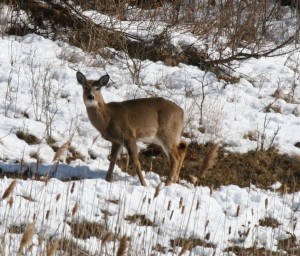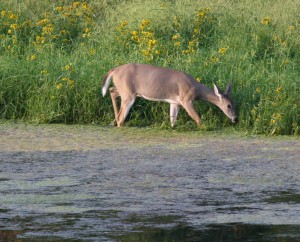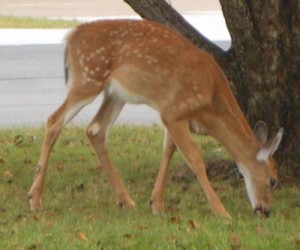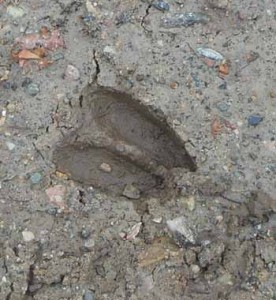Bobcat, Felis rufus
General
The Bobcat, Felis rufus, is the most abundant and widespread native wild cat in North America, named for its short tail that has a docked or “bobbed” appearance. The bobcat is an elusive mammal has been forced to become highly adaptive and can be found in a variety of environments because of habitat loss due to human development.
Description
Bobcats are nearly twice the size of a common housecat, they measure 26” to 41” from head to tail (the tail measuring 4” to 7” in length,) and 17.5” to 23” tall at the shoulder. They are named for their short tails that appear “bobbed” or cut. On average, females are smaller than males. Adult bobcats weigh between 11 lbs. and 30 lbs. Bobcats have long legs and large paws (1) and make tracks that are approximately 2” in diameter (about double the width of housecat tracks) (2). They can be easily identified by the short tufts of hair on their ears (similar to those of the Canada Lynx,) and long, striped ruffs of hair along the sides of the head that create the illusion of sideburns.
Bobcats have an overall brown, buff, or brown-red coat accented by a white underside, black-tipped tail and ears, and dark stripes and spots on the body. In the winter, their coats may grey or dull.3
Bobcats are elusive and nocturnal, making them hard to observe in the wild. They tend to be solitary creatures and only interact during the mating season. Their home ranges are between .5 and over 2.5 square miles, depending on the time of year and location. Male bobcats have larger ranges than females and tend to overlap their ranges with those of several females and sometimes that of another male. Female bobcat ranges do not overlap. Bobcats are territorial and use scent markers to distinguish their ranges and repel intruders. These scent markers may include urine, feces, anal secretions, scratchings, and scrapes (piles of debris collected by a bobcat and marked with their scent.) Bobcats also communicate through sound, although this is typically reserved for the mating season when bobcats produce yowls and hisses. In addition to communication, bobcats also use keen vision, smell, and hearing to navigate their environments and interactions.
Bobcats spend the majority of time on the ground but are agile climbers and can swim.
In the wild, bobcats live an average of 10 to 12 years while in captivity they may live as long as 32 years. (4)
Habitat
Bobcats have adapted to a diverse range of temperate habitats, including forests, deserts, swamps, brush land, mountains, and suburban areas (5). This diversification has been a necessary result of habitat loss due to development. They prefer habitats with minimal snow accumulation, since (unlike the lynx) bobcat paws are not adapted to navigate across deep snow. (6)
Bobcats build hidden dens in hollow trees, thickets, brush piles, and rocky outcroppings or crevices. While hidden, these dens can be recognized by the strong odors that tend to come from them.
Adults face few threats in their habitats other than humans. Natural enemies are coyotes, wolves and mountain lions. Their kittens are prey to large owls, coyotes, and foxes.
Location
Bobcats can be found across most of North America, from southern parts of Canada through Mexico. Within the United States, bobcat populations tend to be densest in the southeast (7).
Diet
Bobcats are opportunistic carnivores and fierce hunters, whose diets consist mainly of rabbits, birds, rodents, and small game (although they are capable of taking down prey much larger then themselves, such as deer.) They have also been known to prey on domestic animals – small dogs as well as outdoor cats. Bobcats are stealthy hunters, using sight and sound to stalk their prey. They wait motionless, then pounce up to 10’, grabbing their prey by the neck and biting through the vertebrae. If a bobcat does not consume its entire kill at once, it will cover the remains with debris or snow and revisit the carcass for future feedings.8
Breeding
Bobcats are solitary animals and only interact for courtship during the mating season. Breeding occurs once a year (usually in the spring,) during which time females may have multiple partners. After mating, male bobcats play no additional part in reproduction or rearing of the kittens.
Gestation lasts for 60 to 70 days, at which point the female will find a private den and have a little of one to six kittens. The kittens open their eyes at 10 days old and nurse for the first two months. Before the young set out on their own at 9 to 12 months old, their mother brings them meat and teaches them to hunt. Female bobcats reach sexual maturity by one year old, and males by two years.9
Notes of Interest
Bobcats are still trapped for their fur in certain parts of their range.
They are the most widespread and abundant wild cat native to North America. It is estimated that there are as many as one million bobcats in the United States alone.10 With that said, bobcats are quite rare in certain parts of their range, warranting hunting regulations and protection acts.
The Mexican bobcat, Lynx rufus escuinapae, a subspecies of Lynx rufus, is native to central Mexico and listed as endangered by the U.S. Fish and Wildlife Service.11
Bobcats are also referred to as Wildcats, Bay Lynx, Barred Bobcats, Pallid Bobcats, and Red Lynx.12
1. http://animals.nationalgeographic.com/animals/mammals/bobcat/
2. http://wdfw.wa.gov/living/bobcats.html
3. http://www.nhptv.org/natureworks/bobcat.htm
4. http://animaldiversity.ummz.umich.edu/accounts/Lynx_rufus/
5. http://animals.nationalgeographic.com/animals/mammals/bobcat/
6. http://wdfw.wa.gov/living/bobcats.html
7. http://animaldiversity.ummz.umich.edu/accounts/Lynx_rufus/
8. http://wdfw.wa.gov/living/bobcats.html
9. http://animaldiversity.ummz.umich.edu/accounts/Lynx_rufus/
10. http://animals.nationalgeographic.com/animals/mammals/bobcat/
11. http://animaldiversity.ummz.umich.edu/accounts/Lynx_rufus/
12. http://www.mnh.si.edu/mna/image_info.cfm?species_id=144
http://animals.nationalgeographic.com/animals/mammals/bobcat/
http://animaldiversity.ummz.umich.edu/accounts/Lynx_rufus/
http://www.mnh.si.edu/mna/image_info.cfm?species_id=144
http://www.nhptv.org/natureworks/bobcat.htm
http://www.tpwd.state.tx.us/huntwild/wild/species/bobcat/
http://wdfw.wa.gov/living/bobcats.html




